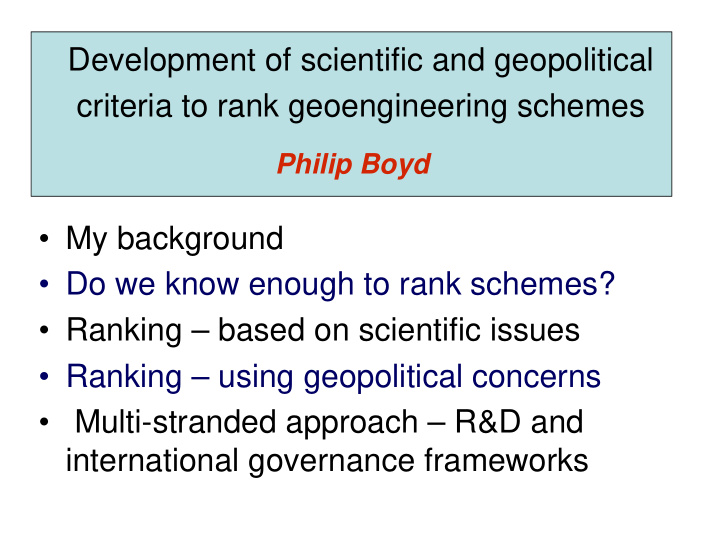



Development of scientific and geopolitical criteria to rank geoengineering schemes Philip Boyd • My background • Do we know enough to rank schemes? • Ranking – based on scientific issues • Ranking – using geopolitical concerns • Multi-stranded approach – R&D and international governance frameworks
My background – large scale scientific experiments Into ocean iron enrichment
Why now? Time is short Avoiding the risks of dangerous climate change requires that global greenhouse gas emissions peak within the next fifteen years are halved relative to 1990 by 2050, and then decline to less than 10 Gigatonnes (GT) of emissions (1 Lord Stern 2008 tonne per capita).
Time is short Years Research Scientific issues Design ranking Technological advances scheme & Test-beds and trials Implementation conduct initial decisions ranking Geopolitical concerns International governance & Legislative structures
Proliferation of schemes
>15 Years of press coverage on Geo-engineering but no science SO Do we know enough to rank schemes?
Ranking geo-engineering schemes Boyd (2008) Nature Geosciences
Rationale – historical precedents “This can be achieved by burning S 2 or H 2 S, carried into the stratosphere on balloons and by artillery guns to produce SO 2 .” “In the stratosphere, SO 2 is converted into sub-micrometer sulfate particles. This has been observed in volcanic eruptions e.g., Mount Pinatubo which injected some 10 Tg S, initially as SO 2 , into the tropical stratosphere” “This cooled the earth’s surface on average by 0.5 ◦ C in the year following the eruption.”
Rationale - Degree of testing “The end result of this field experiment was rapid delivery (<2 h for a 300 m transit) of deep water to the surface ocean followed by catastrophic failure of pump materials under the dynamic stresses of the oceanic environment.” White et al. (2009) Ocean Tech.
Affordability - initial estimate 2 $ a tonne for ocean fertilisation “200 boats, 8.1 M tons of iron, 16 M square miles of HNLC ocean – 8 Gigatons of CO2 each year” “Dumping Iron”, Michael Markels Interview in Wired, November 2000
Affordability - including side-effects 50-300 $ a tonne 7 6 SERIES export below 150m 5 SERIES export 50m Reference 4 NABE bloom export 3 SERIES mixed layer Fe:C 2 S. Ocean phytoplankton Boyd (2008) 1 Markels Mar. Ecol. Prog. Ser. 0 0 50 100 150 200 250 300 350 C ost ($ U S per Tonn e C seq uestered)
Safety - side-effects The Earth System is a complex circuit diagram Pinatubo also caused: Drought – hydrological cycle Ozone depletion Acid rain Aerosols into the ocean Trenberth & Dai (2007) GRL
the Rumsfeld suite of permutations Side-effects – et al. (2005) Thingstad
Safety - System complexity Brewer et al. (1999) Jickells et al. (2005) BIO-geoengineering is most complex
Safety - Verification No schemes have been trialled or tested System complexity will impact verification Biogeochemical > geochemical > physico-chemical
Rapidity - Mitigation rate 300 Fe ( mol/kg ice) [CO 2 ] (ppmv) 280 1.5 260 CO 2 Socolow & Pacala (2004) 240 1.0 220 200 0.5 Iron 180 20 40 60 80 100 120 140 160 Age (1000 yr) Martin (1990)
Vaclav Smil Emergency stop Rapidity -
Ranking geo-engineering schemes Boyd (2008) Nature Geosciences
GEOPOLITICS & GEO-ENGINEERING All modelling experiments to date suggest that the deleterious impacts of climate change will be unevenly spread across the planet Boyd & Doney (2002) GRL
Also it is recognised that both the beneficial & detrimental effects, resulting from geoengineering will also be unequally distributed. Robock et al. (2009) GRL
GEOPOLITICAL IMPLICATIONS NODC “In addition to the impacts of climate change, geoengineering may concurrently diminish resource availability at the regional scale, increasing the potential for conflict between nations over resources.” “Second, the attribution of the cause(s) of such diminished resources will be difficult and contentious.” Boyd (in press) Nature Geosciences
Large scale ocean fertilisation will probably result in the consumption of nutrients destined for other ocean basins – raising issues of SCALE & ATTRIBUTION Sarmiento et al. (2004) Nature
Detection & attribution of the impact of a geoengineering scheme will be confounded by: concurrent emissions & climate change Raupach et al. (2006) Other geoengineering schemes Altered C sinks, unanticipated feedbacks, climate variability Le Quere et al. (2007)
Its not only the scale of geoengineering schemes – but also dispersal – implications for provenance Animation courtesy F. Chai (U. Maine)
Participation & replication Artificial trees Stratospheric S injection
Conflict avoidance – loss of resources such as ocean or land productivity Science 2008 Models indicate that sustained ocean iron fertilization can also lead to anoxia
Ranking geo-engineering schemes Boyd (2008) Nature Geosciences
Time is short Years Research Scientific issues Design ranking Technological advances scheme & Test-beds and trials Implementation conduct initial decisions ranking Geopolitical concerns International governance & Legislative structures
Recommend
More recommend